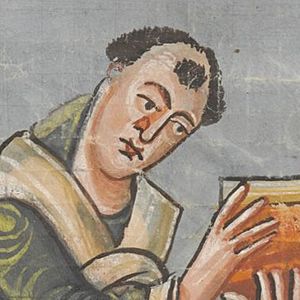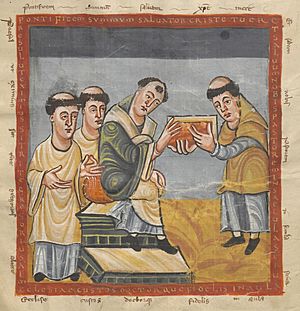Pope Gregory IV facts for kids
Quick facts for kids Pope Gregory IV |
|
|---|---|
| Bishop of Rome | |

Miniature of Pope Gregory IV (c. 840)
|
|
| Church | Catholic Church |
| Papacy began | October 827 |
| Papacy ended | 25 January 844 |
| Predecessor | Valentine |
| Successor | Sergius II |
| Orders | |
| Created Cardinal | 797 |
| Personal details | |
| Born | Rome, Papal States |
| Died | 25 January 844 Rome, Papal States |
| Other Popes named Gregory | |
Pope Gregory IV (Latin: Gregorius IV) was the leader of the Catholic Church and ruler of the Papal States from October 827 until his death on January 25, 844. He is remembered for trying to help solve arguments between Emperor Louis the Pious and his sons. His time as pope also saw the Carolingian Empire split apart in 843.
Becoming Pope
Gregory was the son of a noble Roman man named John. He was known for being a kind and learned churchman. He became a priest when Pope Paschal I was pope. When Pope Valentine died in 827, Gregory was a cardinal priest at the Basilica of St Mark in Rome.
Like the pope before him, Gregory was chosen by the important noble families of Rome. Everyone agreed he was the best person to become the new Bishop of Rome. They found him at the Basilica of Saints Cosmas and Damian. Even though he didn't want the job at first, he was taken to the Lateran Palace. He was then officially made pope-elect in October 827.
His official ceremony to become pope was delayed until March 29, 828. This was because Emperor Louis the Pious had to approve his election first. A rule from 824 said that no pope could be made official without the emperor's approval. The emperor even told Gregory off for trying to become pope too soon. Gregory accepted the emperor's power. In 828 and 829, he sent messages to Louis for talks.
In January 829, Gregory had a disagreement with Farfa Abbey. This was about who owned some church land. A court, with a bishop and the emperor's representative, decided in favor of the abbey. They said the land should go back to the monastery. Gregory did not agree with this decision. But there is no proof he was able to change it.
Arguments in the Empire

In 817, Emperor Louis the Pious had divided his empire among his three sons from his first marriage. These sons were Lothair I, Pepin I of Aquitaine, and Louis the German. Over time, the pope's reliance on the Carolingian Empire lessened. This was due to the many arguments between Louis the Pious and his sons.
In 829, Louis decided to change the plan for dividing the empire. He gave a kingdom to his youngest son, Charles the Bald. Gregory wrote a letter to the Frankish bishops, saying this was wrong. In October 830, after a short rebellion, Gregory said that Louis's second wife, Judith, should be released. She had been forced to become a nun, and Gregory said she should return to Louis.
When the war between Louis and his sons started again in 833, Lothair asked Gregory for help. Gregory left Rome to join Lothair, hoping to bring peace. But this made the Frankish bishops who supported Louis angry. They thought Gregory was helping Lothair. They even threatened to remove Gregory as pope if he tried to remove them from the church.
Gregory insisted that the pope was more important than the emperor. But most Frankish bishops believed the pope should not get involved in their kingdom's issues. They thought all bishops were equal, and the pope was not above them in these matters.
The armies of Louis and two of his sons met on June 24, 833. The sons convinced Gregory to go to Louis's camp to talk. At first, Louis did not treat Gregory with respect. But Gregory convinced Louis that he meant well. Gregory returned to Lothair to try and make peace. However, Gregory soon realized Lothair had tricked him. Gregory was stopped from going back to the emperor. Louis was left by his supporters and had to give up. Louis was removed from power, and Lothair was declared emperor. After this, Gregory went back to Rome. Louis was put back in power in 834 after another family argument. But he was weaker, and Lothair kept control of Italy.
The emperor then sent a group to see Gregory. They wanted to ask him about what happened when Louis was removed. Gregory swore an oath that he had good intentions. He said he always wanted a peaceful solution between Louis and his sons. The emperor's messengers believed Gregory and returned to Louis. After this, Gregory mostly focused on church matters for the rest of his time as pope.
In 836, Lothair, who was king of the Lombards, started taking things from the Roman church. Gregory asked Louis for help. The emperor sent someone to investigate. Gregory, even though he was sick, told the messenger what was happening. He asked him to take a letter to the emperor about Lothair's actions. In 840, Louis died, and Lothair became emperor. War started again between Louis's sons. Gregory tried to help make peace, but he was not successful. The Treaty of Verdun in 843 then broke up the empire of Charlemagne. Lothair kept the title of emperor and control of Italy.
Building and Church Work
Gregory repaired the Aqua Traiana, an old Roman water system. After 841, he rebuilt and strengthened parts of the port of Ostia. This was to protect it from attacks by Saracens. He renamed it Gregoriopolis. Around the same time, he restored a town called Galeria. He also started a new town called Draco, near the Tiber River. This was the first time a pope developed land in his own territory.
Gregory also helped improve Rome's buildings. In 833, he completely rebuilt St Mark’s Basilica in Rome. He decorated its walls with beautiful Byzantine-style mosaics. He also repaired or rebuilt several other churches. He rebuilt the entrance area of St. Peter’s Basilica. Inside, he moved the body of Saint Gregory to a new chapel. He also moved the bodies of Saint Sebastian, Saint Tiburtius, and Saint Gorgonius from the Catacombs of Rome. He raised the altar in the church of Santa Maria in Trastevere. He also started a monastery near that church.
During Gregory's time as pope, the argument about iconoclasm ended in the Byzantine Empire. Gregory also encouraged the celebration of All Saints' Day in the Frankish kingdom. He appointed Ansgar as archbishop of Hamburg-Bremen in 832. Ansgar also became the pope's special representative for northern and eastern Europe.
Gregory also helped settle church disputes. He supported Venerius, the patriarch of Grado, in his claim over bishops in Istria. When a church meeting gave power to another patriarch, Venerius asked Gregory for help. Gregory supported Venerius.
Gregory was also asked to help in the case against Aldric of Le Mans. Aldric was being forced out of his church position. On July 8, 833, Gregory wrote to bishops in Europe. He said Aldric had the right to ask the pope for help. He also said no one could judge Aldric until the pope made a decision. This letter helped Aldric stay in his position for some time.
Pope Gregory IV died on January 25, 844. He was buried in St. Peter’s Basilica. Sergius II became the next pope.
See also
 In Spanish: Gregorio IV para niños
In Spanish: Gregorio IV para niños



